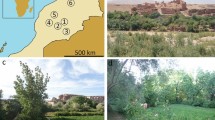Summary:
We compare the behaviour of daughters of Evylaeus albipes females from eusocial populations from the West of France with those from a non-eusocial population from the East of the country. When non-eusocial population females are placed in the laboratory under day lengths and temperature conditions similar to those experienced by eusocial foundresses under natural conditions, all five produced a brood of males and overwintering daughters with no workers. When 18 nests were initiated by non-eusocial foundresses under short summer daylengths but warmer than normal temperatures, two produced one worker amongst overwintering female and male brood. Both worker-producing non-eusocial females were from the warmest of the eastern localities. When foundresses of the social population are placed under day length conditions typical for the non-eusocial population but with temperature conditions that are intermediate between the two, all five produced at least one worker. Similarly, if the first brood produced by social foundresses is removed, they raise another brood that contains workers whereas non-eusocial population foundresses who have their first brood removed produce a second brood of overwintering females (although one foundress, again from the warmest of the non-eusocial localities, produced one worker in each of two broods, also with males and overwintering females). We conclude that i) non-eusocial foundresses do not readily produce workers under long summer conditions; ii) the lack of worker production by most non-eusocial population females is not because they cannot produce two broods, but because they have a tendency not to produce workers; iii) eusocial population daughters will become active without diapausing in the presence of any other female - even of the closely related E. calceatus, unless the first individual to eclose is the smallest and iv) social population foundresses are incapable of producing overwintering females without the help of workers. These data show an interesting combination of flexibility and constraint on social behaviour in these bees.
Similar content being viewed by others
Author information
Authors and Affiliations
Additional information
Received 27 July 1998; revised 11 August 1999 and 14 January 2000; accepted 15 February 2000.
Rights and permissions
About this article
Cite this article
Plateaux-Quénu, C., Plateaux, L. & Packer, L. Population-typical behaviours are retained when eusocial and non-eusocial forms of Evylaeus albipes (F.) (Hymenoptera, Halictidae) are reared simultaneously in the laboratory. Insectes soc. 47, 263–270 (2000). https://doi.org/10.1007/PL00001713
Issue Date:
DOI: https://doi.org/10.1007/PL00001713




